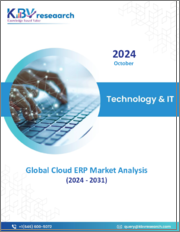
|
시장보고서
상품코드
1846134
세계의 SAP HANA 및 S4HANA 시장 규모 : 전개 방식별, 조직 규모별, 용도별, 지역별 범위 및 예측Global SAP HANA and S4HANA Market Size By Deployment Type, By Organization Size, By Application, By Geographic Scope And Forecast |
||||||
SAP HANA 및 S4HANA 시장 규모와 예측
SAP HANA 및 S4HANA 시장 규모는 2024년에는 262억 9,000만 달러로 평가되었으며, 2031년에는 1,053억 3,000만 달러에 달할 것으로 예측되며, 예측 기간인 2024-2031년 CAGR은 27.4%로 성장할 것으로 예측됩니다.
세계 SAP HANA 및 S4HANA 시장 촉진요인
SAP HANA 및 S4HANA 시장의 성장과 개척은 특정 주요 시장 촉진요인에 기인합니다. 주요 시장 동인 중 일부는 다음과 같습니다:
디지털 전환에 대한 노력 : 디지털 전환에 대한 노력 : 디지털 전환 계획을 실행하는 기업이 늘어남에 따라 SAP HANA 및 S/4HANA와 같은 고급 데이터 관리 및 실시간 분석 툴에 대한 요구가 증가하고 있습니다. 이러한 플랫폼은 의사결정과 비즈니스 민첩성을 향상시키는 강력한 인메모리 컴퓨팅 기능을 갖추고 있습니다.
클라우드 도입 : 가장 큰 이유 중 하나는 클라우드 컴퓨팅에 대한 추세가 강화되고 있다는 점입니다. 클라우드, 온프레미스, 하이브리드 모델 등 다양한 도입 옵션을 제공하는 SAP HANA와 S/4HANA를 통해 기업은 필요에 따라 최적의 환경을 선택할 수 있습니다.
대규모 데이터 및 분석 : 산업 전반에 걸쳐 대규모 데이터가 폭발적으로 증가함에 따라 강력한 데이터 처리 및 분석 솔루션이 요구되고 있습니다. SAP HANA의 인메모리 기술은 실시간 데이터 처리를 가능하게 하고, 실행 가능한 인사이트를 빠르게 얻고자 하는 기업에게 매우 중요합니다.
규제 준수 및 보안 : 기업들은 엄격한 규정을 준수하고 높은 보안 기준을 유지하기 위해 컴플라이언스 도구와 강력한 보안 기능이 내장된 S/4HANA와 같은 고급 ERP 솔루션을 채택하고 있습니다.
레거시 시스템 마이그레이션 : 오래된 ERP 시스템을 사용하는 조직은 새로운 기능, 향상된 확장성 및 우수한 성능을 활용하기 위해 S/4HANA로 마이그레이션을 진행하고 있습니다. 이 전환은 레거시 SAP 시스템의 지원 종료로 인해 더욱 가속화될 것입니다.
사용자 경험 향상 : SAP Fiori가 채택된 주요 이유 중 하나는 SAP S/4HANA 사용자에게 보다 개인화되고 반응성이 뛰어나며 직관적인 인터페이스를 제공하기 때문입니다.
세계 SAP HANA 및 S4HANA 시장 억제요인
SAP HANA 및 S4HANA 시장에는 성장의 여지가 많지만, 이를 어렵게 만드는 몇 가지 산업적 제약이 있습니다. 업계 이해관계자들이 이러한 어려움을 이해하는 것이 필수적입니다. 시장 제한의 주요 내용은 다음과 같습니다:
높은 도입 비용 : SAP HANA 및 S/4HANA를 도입하기 위해서는 많은 초기 비용이 소요됩니다. 물리적 인프라, 소프트웨어 라이선스, 컨설팅 서비스 등의 비용이 포함되기 때문에 특히 중소기업(SME)에게는 비용이 많이 드는 사업입니다.
마이그레이션의 복잡성 : 기존 시스템을 SAP HANA 또는 S/4HANA로 전환하는 것은 어렵고 시간이 많이 걸리는 과정입니다. 이 프로세스는 시스템 통합, 커스터마이징, 데이터 마이그레이션을 수반하는 경우가 많으며, 이 모든 것이 업무에 큰 혼란을 초래할 수 있고, 많은 준비와 지식이 필요합니다.
기술 부족 : SAP HANA 및 S/4HANA 시스템 설정, 운영 및 유지보수에 필요한 특정 지식은 필요성은 높지만 부족합니다. 자격을 갖춘 인력이 부족하여 비용이 많이 들고 도입이 늦어질 수 있습니다.
긴 도입 기간 : 비즈니스 프로세스의 복잡성과 조직 규모에 따라 SAP HANA와 S/4HANA를 완전히 통합하는 데 오랜 시간이 소요될 수 있습니다. 리소스가 적은 기업이나 더 빠른 결과를 원하는 기업은 이 긴 타임라인에 실망할 수 있습니다.
목차
제1장 소개
- 시장 정의
- 시장 세분화
- 조사 방법
제2장 주요 요약
- 주요 조사 결과
- 시장 개요
- 시장 하이라이트
제3장 시장 개요
- 시장 규모와 성장의 가능성
- 시장 동향
- 시장 성장 촉진요인
- 시장 성장 억제요인
- 시장 기회
- Porter's Five Forces 분석
제4장 SAP HANA 및 S4HANA 시장 : 전개 방식별
- 온프레미스
- 클라우드 기반
제5장 SAP HANA 및 S4HANA 시장 : 용도별
- 펄프·제지
- 재무·관리(FICO)
- 공급망 관리(SCM)
- 고객관계관리(CRM)
- 인적자본 관리(HCM)
- 기업 자산 관리(EAM)
- 생산 계획(PP)
- 판매 유통(SD)
제7장 SAP HANA 및 S4HANA 시장 : 조직 규모별
- 중소기업(SMEs)
- 대기업
제8장 지역별 분석
- 북미
- 미국
- 캐나다
- 멕시코
- 유럽
- 영국
- 독일
- 프랑스
- 이탈리아
- 아시아태평양
- 중국
- 일본
- 인도
- 호주
- 라틴아메리카
- 브라질
- 아르헨티나
- 칠레
- 중동 및 아프리카
- 남아프리카공화국
- 사우디아라비아
- 아랍에미리트
제9장 시장 역학
- 시장 성장 촉진요인
- 시장 성장 억제요인
- 시장 기회
- COVID-19의 시장에 대한 영향
제10장 경쟁 구도
- 주요 기업
- 시장 점유율 분석
제11장 기업 개요
- Dow Chemical Company
- AkzoNobel
- Olin Corporation
- Occidental Petroleum Corporation
- Formosa Plastics Corporation
- Tata Chemicals Limited
- Tosoh Corporation
- Hanwha Chemical Corporation
- Shin-Etsu Chemical Co., Ltd.
제12장 시장 전망 시장 전망과 기회
- 신기술
- 향후 시장 동향
- 투자 기회
SAP HANA and S4HANA Market Size And Forecast
SAP HANA and S4HANA Market size was valued at USD 26.29 Billion in 2024 and is projected to reach USD 105.30 Billion by 2031, growing at a CAGR of 27.4 % during the forecast period 2024-2031.
Global SAP HANA and S4HANA Market Drivers
The growth and development of the SAP HANA and S4HANA Markets is attributed to certain main market drivers. Several of the major market forces are as follows:
Initiatives for Digital Transformation: As more businesses implement digital transformation plans, there is a greater need for sophisticated data management and real-time analytics tools like SAP HANA and S/4HANA. These platforms have strong in-memory computing capabilities that improve decision-making and business agility.
Cloud Adoption: One major reason is the increasing tendency toward cloud computing. With a range of deployment choices available, including cloud, on-premise, and hybrid models, SAP HANA and S/4HANA enable businesses to select the best environment for their needs.
large Data and Analytics: Robust data processing and analytics solutions are needed due to the explosion in large data generation across industries. Real-time data processing is made possible by SAP HANA's in-memory technology, which is crucial for enterprises looking to swiftly obtain actionable insights.
Regulatory Compliance and Security: Organizations are adopting advanced ERP solutions such as S/4HANA, which come with built-in compliance tools and strong security features, in order to comply with strict rules and maintain high security standards.
Legacy System Migration: Organizations utilizing more antiquated ERP systems are moving more and more to S/4HANA in order to take advantage of its more recent capabilities, enhanced scalability, and superior performance. This transfer is also expedited by the end of support for legacy SAP systems.
Improved User Experience: One of the main reasons for SAP Fiori's adoption is that it provides a more personalized, responsive, and intuitive interface for users of SAP S/4HANA.
Global SAP HANA and S4HANA Market Restraints
The SAP HANA and S4HANA Market has a lot of room to grow, but there are several industry limitations that could make it harder for it to do so. It's imperative that industry stakeholders comprehend these difficulties. Among the significant market limitations are:
High Implementation Costs: SAP HANA and S/4HANA implementation can come with a hefty upfront cost. Costs for physical infrastructure, software license, and consulting services are included, which makes it an expensive undertaking, particularly for small and medium-sized businesses (SMEs).
Migration Complexity: Converting traditional systems to SAP HANA or S/4HANA can be a difficult and drawn-out process. The process frequently entails system integration, customisation, and data migration, all of which can cause major disruptions to business operations and call for a great deal of preparation and knowledge.
Lack of Skill: There is a strong need for but a shortage of the specific knowledge required to set up, run, and maintain SAP HANA and S/4HANA systems. The lack of qualified personnel may raise expenses and cause deployment delays.
Long Implementation Time: Depending on the complexity of the business processes and the scale of the organization, it may take a long time to fully integrate SAP HANA or S/4HANA. Businesses with low resources or those who require faster results may be discouraged by this lengthy timeline.
Global SAP HANA and S4HANA Market Segmentation Analysis
The Global SAP HANA and S4HANA Market is Segmented on the basis of Deployment Type, Organization Size, Application, and Geography.
SAP HANA and S4HANA Market, By Deployment Type
On-Premise: SAP HANA and S/4HANA are installed on the company's own servers and maintained by internal IT staff. This deployment is preferred by organizations with strict data security, compliance, and customization requirements.
Cloud-Based: SAP HANA and S/4HANA are hosted on cloud infrastructure, offering flexibility, scalability, and reduced upfront costs.
SAP HANA and S4HANA Market, By Organization Size
Small and Medium-Sized Enterprises (SMEs): Organizations with limited resources and smaller IT budgets. They often prefer cloud-based deployments due to lower initial costs and scalability.
Large Enterprises: Organizations with extensive IT infrastructure and budgets. They may choose on-premise, cloud, or hybrid deployments depending on their specific needs, such as security, customization, and compliance.
SAP HANA and S4HANA Market, By Application
Finance and Controlling (FICO): Modules that manage financial accounting, controlling, and financial reporting processes.
Supply Chain Management (SCM): Tools for optimizing supply chain processes, including procurement, production, and distribution.
Customer Relationship Management (CRM): Modules for managing customer interactions, sales, and service processes.
Human Capital Management (HCM): Modules for managing employee data, payroll, and talent management.
Enterprise Asset Management (EAM): Solutions for maintaining and managing physical assets across their lifecycle.
Production Planning (PP): Tools for planning and managing manufacturing processes and operations.
Sales and Distribution (SD): Modules for managing sales processes, order fulfillment, and distribution logistics.
SAP HANA and S4HANA Market, By Geography
North America
Europe
Asia-Pacific
Latin America
Middle East and Africa
Key Players
- The major players in the SAP HANA and S4HANA Market are:
- SAP SE
- IBM Corporation
- Microsoft Corporation
- Amazon Web Services (AWS)
- Oracle Corporation
- Accenture
- Capgemini
- Deloitte
- Infosys Limited
- Tata Consultancy Services (TCS)
- Wipro Limited
TABLE OF CONTENTS
1. Introduction
- Market Definition
- Market Segmentation
- Research Methodology
2. Executive Summary
- Key Findings
- Market Overview
- Market Highlights
3. Market Overview
- Market Size and Growth Potential
- Market Trends
- Market Drivers
- Market Restraints
- Market Opportunities
- Porter's Five Forces Analysis
4. SAP HANA and S4HANA Market, By Deployment Type
- On-Premise
- Cloud-Based
5. SAP HANA and S4HANA Market, By Application
- Pulp and Paper
- Finance and Controlling (FICO)
- Supply Chain Management (SCM)
- Customer Relationship Management (CRM)
- Human Capital Management (HCM)
- Enterprise Asset Management (EAM)
- Production Planning (PP)
- Sales and Distribution (SD)
7. SAP HANA and S4HANA Market, By Organization Size
- Small and Medium-Sized Enterprises (SMEs)
- Large Enterprises
8. Regional Analysis
- North America
- United States
- Canada
- Mexico
- Europe
- United Kingdom
- Germany
- France
- Italy
- Asia-Pacific
- China
- Japan
- India
- Australia
- Latin America
- Brazil
- Argentina
- Chile
- Middle East and Africa
- South Africa
- Saudi Arabia
- UAE
9. Market Dynamics
- Market Drivers
- Market Restraints
- Market Opportunities
- Impact of COVID-19 on the Market
10. Competitive Landscape
- Key Players
- Market Share Analysis
11. Company Profiles
- Dow Chemical Company
- AkzoNobel
- Olin Corporation
- Occidental Petroleum Corporation
- Formosa Plastics Corporation
- Tata Chemicals Limited
- Tosoh Corporation
- Hanwha Chemical Corporation
- Shin-Etsu Chemical Co., Ltd.
12. Market Outlook and Opportunities
- Emerging Technologies
- Future Market Trends
- Investment Opportunities



















